
| At a glance | |
|---|---|
| Product | Western Digital Sentinel DX4000 Small Office Storage Server (WDBLGT0080KBK) [Website] |
| Summary | Four-bay small business Intel D525 Atom based NAS running on Windows Storage Server 2008 R2 Essentials |
| Pros | • Bundled bare-metal client backup • Handles up to 25 users • Provision for dual external power supplies (one supplied) • USB 3.0 ports |
| Cons | • No power save mode • Fan runs full blast when system is off • Extremely long RAID re-initialization times • No Apple Time Machine support • Limited backup options |
Typical Price: $780 Buy From Amazon
Introduction
If you’re searching for a business-class four drive NAS device, you’ll find that most of your choices are Linux-based. Recently, both Buffalo Technology and Western Digital have introduced business-class NASes based on Windows Storage Server 2008 R2 technology. One of the obvious benefits of using the Windows Storage Server platform is the ease of integration into Windows Domain and Active Directory environments.
In this review, I’ll be focusing on Western Digital’s new Sentinel DX4000 Small Office Storage Server. The DX4000 is based on Windows Storage Server 2008 R2 Essentials – the entry level of Microsoft’s storage server product offerings.
Tim already posted a hardware and performance review that you’ll probably also want to read. I won’t be duplicating Tim’s content, but will focus on my installation experience and a walk through the DX4000’s key features.
Setup
The physical setup of the DX4000 is identical to virtually every other NAS product on the market. You plug it in to your Ethernet network, connect the power supply and press the power button. It takes the server a couple of minutes to start up. When the LCD display shows WDSENTINEL and the IP address is obtained from your network, you can begin your setup.
There is no CD included with the server. All of the software that you need is stored on the server. Just open your browser and type http://<ip address>/connect. (<ip address> is the IP address displayed on the DX4000’s LCD display.)
The first time you access the server you are prompted to download and run the setup wizard. The wizard walks you through the following steps:
- Verify Localization settings
- Country or region
- Language
- Keyboard type
- Verify date and time
- Accept Microsoft and Western Digital license terms
- Personalize the WD Sentinel server
- Create a unique name – this is the only opportunity to name the server. The name must be unique
- Create and confirm an administrator password – you MUST remember this password. If you forget it, you may lose all of your data
- Create a password hint.
- Specify how server software should be updated
The LCD screen shows you the progress of the setup and installation. After a few minutes you should see a screen indicating that the server is ready to use.
In order to achieve the maximum benefit of the DX4000, you need to install client software on each Windows and MacOS that will access it. The quick start guide notes that you must install at least one Windows client before installing the MacOS client. As with the server setup, you merely type in http://<ip address>/connect. This takes you to the screen shown in Figure 1:
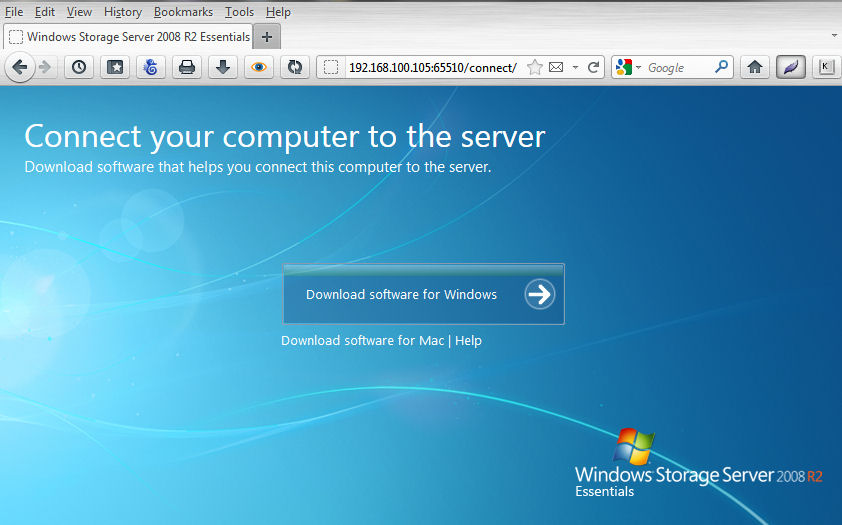
Figure 1: Download client software
Next, a screen displays an overview of the benefits of using the connector software as show in Figure 2:
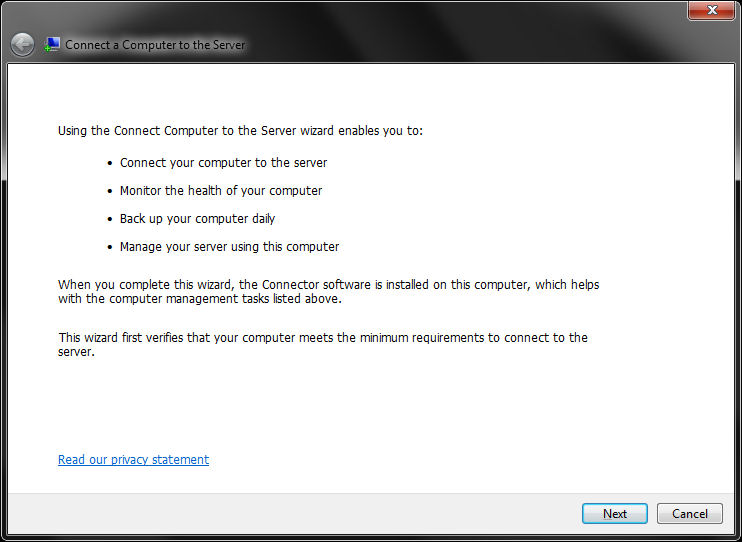
Figure 2: Overview of the client connector benefits
You are warned that your computer may reboot several times during the installation process. In addition, your Windows computer must have Microsoft.NET 4.0 or later. If your computer doesn’t meet the minimum requirements,.Net will be installed as part of the installation. You are also informed that the installation process may take up to 30 minutes.
I discovered during my attempt to install the connector software on multiple computers, that you could only have one installation running at a time. Figure 3 shows the error code that you receive if you try to run simultaneous installations on multiple systems. To me, this could be a problem if you plan to deploy the DX4000 to a medium-sized office.
If each installation could take up to 30 minutes, and you have 20 installations to do, it could take well over a day to deploy the connector on all systems. Fortunately, the connector isn’t mandatory. If you’re willing to give up the benefits shown in Figure 2, you can merely connect to shares that an administrator has previously configured for you.

Figure 3: Only one computer can run the client connect installation at a time
During the installation process, you will be prompted for the administrator password and will be asked to create a unique name for the computer that you are connecting to the server. You will also be given the option to allow the server to wake up the computer (if supported) for backups. Finally, you will be given the option to participate in a Microsoft customer experience improvement program. If all goes well, you’ll see a screen confirming that the software was installed properly.
Setup Problems
Unfortunately, my experience with installing the connector client wasn’t a positive one. I had difficulties installing the client on two Windows XP systems as well as on my Windows 7 64 bit system. WD recommends that all systems be completely up-to-date with all patches applied.
On my Windows 7 system, I had had to uninstall Internet Explorer 9 for another project I was working on. So I had IE 8 installed when I ran the installer. After many hours of poking, prodding and head-scratching, I finally tried reinstalling IE 9, rebooted and found that did the trick. (Now, WD just needs to figure out why that was a problem…)
For one of my XP systems, I received the error shown in Figure 4. I checked my system time and re-synchronized it with a stratum 1 NTP server and tried to reinstall the software.

Figure 4: Error code trying to connect to the network
I then received the warning shown in Figure 5 – most likely due to my failed first attempt.
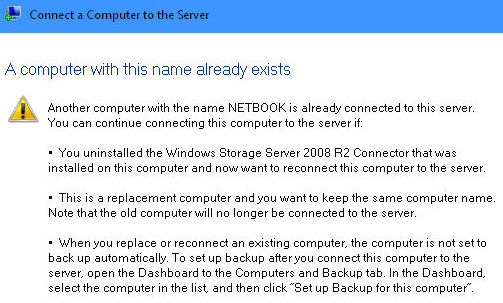
Figure 5: Warning that the computer name already exists
I finally decided to contact tech support. I actually hadn’t yet found the Win 7/IE 9 solution described above when I made the call. So I had not successfully installed connector software on any of my Windows systems. This means I didn’t have access to the administrator’s dashboard that would allow me to gracefully reboot the server through the administrative interface. So the support tech instructed me to pull the power plug to reboot the server.
In retrospect, that wasn’t such a good idea. It probably would have been better to reboot the server by using the power switch, which executes a graceful shutdown. I think I was the first DX4000 tech support call and support has now been instructed not to have customers pull the DX4000’s plug.
While rebooting the server seemed to enable me to install the connector software on both of my XP Windows computers, the ungraceful shutdown had a very bad side effect – the RAID5 drive array started resynchronizing. The resync process lasted 6 days and 8 hours – a time period that I considered far north of excessive.
Part of the problem with the extended synchronization period was that one of my networked computers was also running its initial full backup. Still, when I discussed the extended RAID resynchronization time with Western Digital, they didn’t seem at all surprised at how long it was taking. In fact, they felt the longer resync time was a plus, because they claim to do a more thorough rebuild than their competitors.
For the sake of comparison, I looked back at some of my reviews of other RAID systems to see how long aRAID rebuilds took. On a 5 TB Lacie 5Big-2 NAS, the RAID rebuild took 8 hours and 15 minutes. On a 1 TB Buffalo TeraStation Pro II, it took 1 1/2 hours.
The problems with the extended RAID rebuild on the DX4000 are twofold. First, during the RAID rebuild, the DX4000 is painfully slow. Throughput drops to a fraction of its benchmarked performance. Even access to the administrator’s console took close to two minutes to launch. The second problem is that during the RAID rebuild, you no longer have fault tolerance. A drive failure during the rebuild process will result in total data loss. Though WD did agree that the rebuild time was long, they felt that a rebuild is really a rare anomaly that shouldn’t occur normally.
So unless you want to repeat my painful experience, never, ever unplug the DX4000 while it’s running. Do a graceful shutdown using the front panel power switch. You should also plug the DX4000 (or any NAS) into a UPS. But note that while the DX4000 administrator’s guide makes a reference to connecting a UPS to one of the USB ports, it provides no information on how to configure it, or what UPS brands are supported.
Launchpad
Upon completion of the connector software installation, you’ll find that you have two new programs: Launchpad and Dashboard. I’ll cover Launchpad first.
The Launchpad shown in Figure 6 has a limited number of options and is intended to be used by the clients on their computers. Let’s walk through the features.
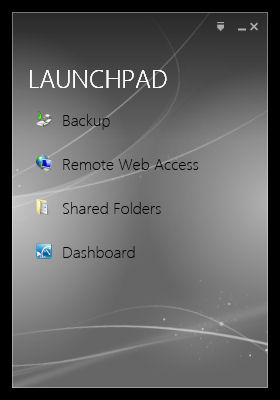
Figure 6: Launchpad used by clients
Backup – This option provides only two choices: Start Backup, which the administrator has pre-configured); and automatically wake up the computer to run a scheduled backup.
Remote Web Access – Prior to using Remote Web Access, the administrator has to set up the DX4000 for remote access and configure user accounts to allow remote access. I’ll discuss that a little later. To access the DX4000 remotely, you open a secure HTTPS session to devicename.remotewebaccess.com (devicename is the name the administrator configured for the DX4000). This is basically a dynamic DNS service hosted by Microsoft that lets you bypass the hassles of router port forwarding (if you have a UPnP-enabled router…more later) and configuring your own dynamic DNS.
After signing in with your username/password, you’ll land at the remote web access home page shown in Figure 7. Here you can see computers attached to the DX4000, view shared folders for which you have permission, and view the Media Library. The Media Library aggregates all of the media content for which you have permission. So whether the media content is in a private share, such as “cellison” below, or in folders named for media types, it’s all aggregated when you browse the library.
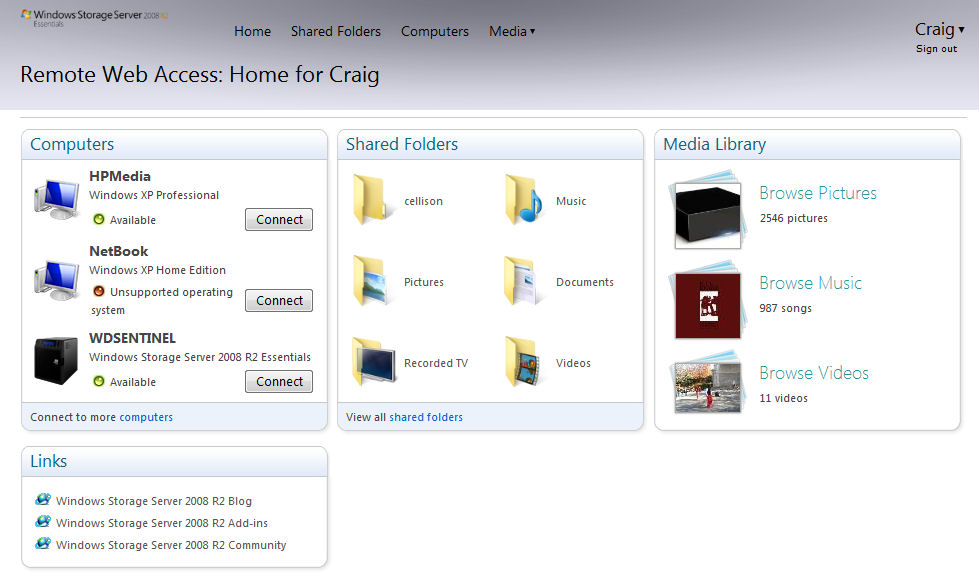
Figure 7: Remote Web Access home page for user Craig
If you click on Shared Folders, you’ll see your files displayed in a browser window similar to Figure 8. You can upload or download files, create new folders, copy, cut, paste and delete files. As with Windows explorer, the column heading lets you sort your files. This is a really nice file management interface.
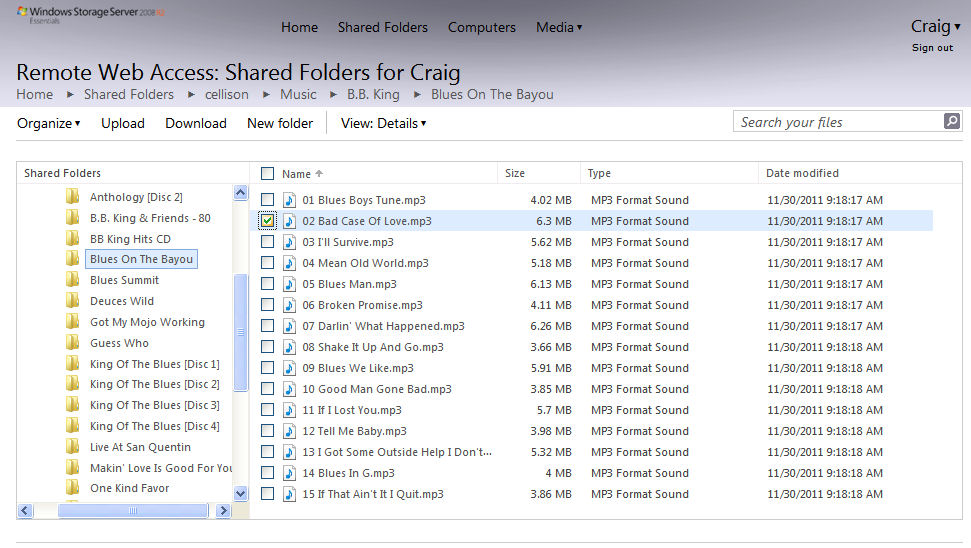
Figure 8: Shared folders
In the Media Library, you can browse pictures, music or videos. For pictures, you can see a traditional thumbnail view of each folder, or you can select Play slideshow. Alternatively, you can search the directory for a file name. Partial names may display multiple matches. Slideshow options are limited to duration: slow, medium or fast. The transition is “dissolve”, and you don’t have the ability to rotate any photos that may be oriented incorrectly.
Figure 9 shows a slideshow in progress. You can navigate directly to any photo by clicking on the corresponding thumbnail on the right side of the screen. Up and down arrows allow you to navigate through all of the photos in a directory.
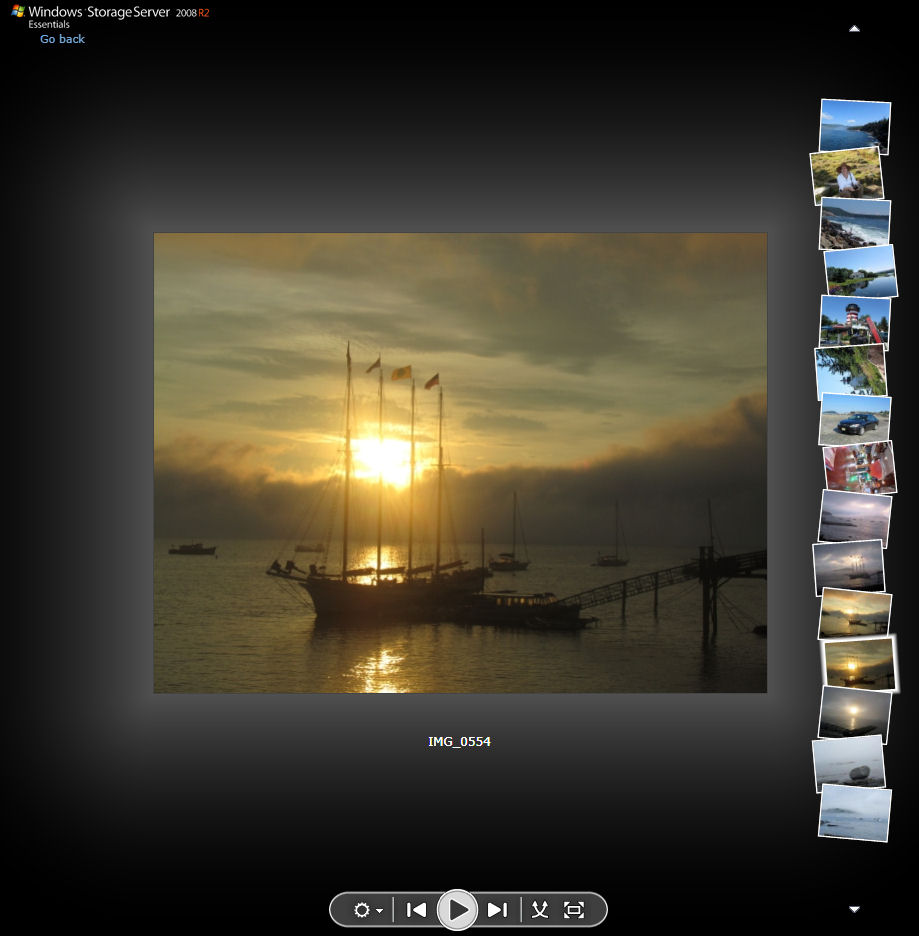
Figure 9: Slideshow served over the web by the DX4000
Similarly, the Remote Web access for the Music library is also robust. Figure 10 shows that you can sort your music by Albums, Artists, Genre, Ratings, Playlists or Songs. Apparently the DX4000 reads the ID3 tags and organizes your library, as all I did was copy some folders onto the server. The server does have a DLNA-compliant media server, but not an iTunes server.
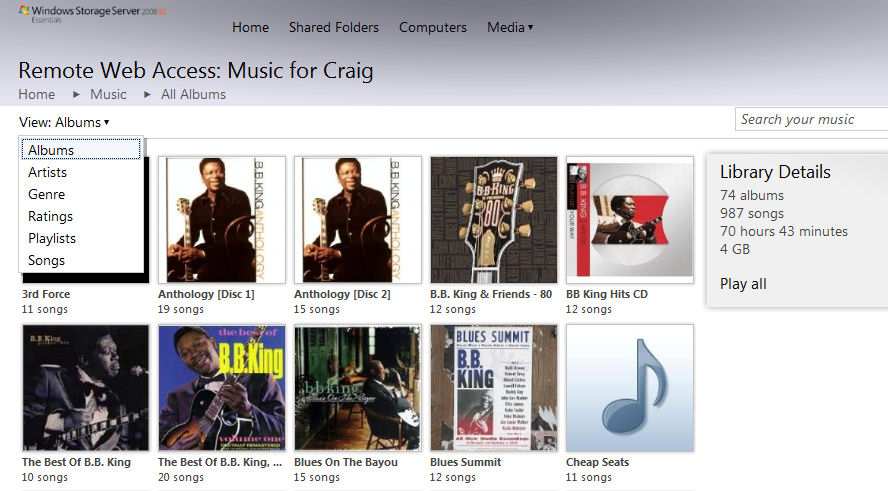
Figure 10: Music interface
Figure 11 shows what the player looks like as you are playing music. The moving background is a collage composed of all of your available album artwork. You can show the current queue, and you can also save queues to a playlist. Note: IE is showing a certificate error, as I’m connecting to the web remote access over my local network. There is no certificate error when you connect remotely over the Internet using the devicename.remotewebaccess.com address.
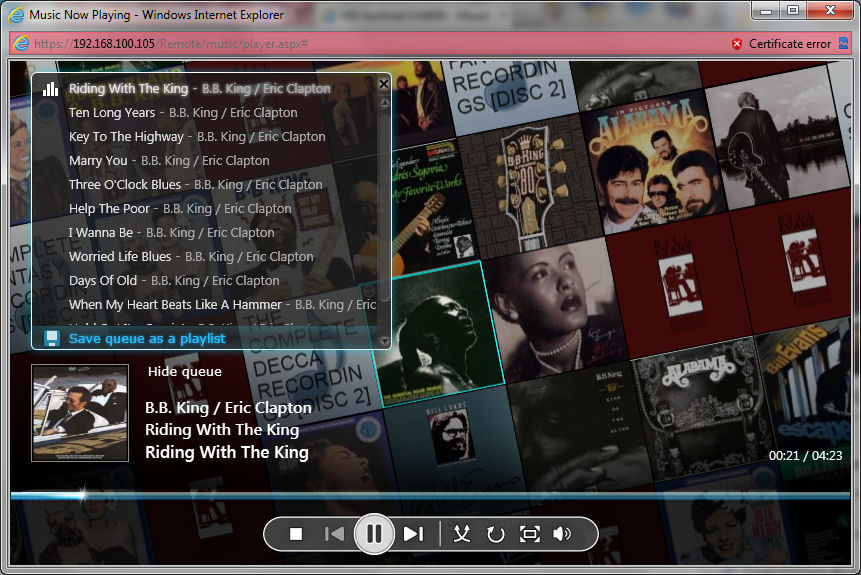
Figure 11: Browser-based media player
I tested slideshows, playing music and playing video in both IE9 and FireFox 8, and everything worked in both browsers. It’s worth noting that Windows Storage Server 2008 R2 Essentials supports on-the-fly video transcoding. Not many NASes do this, so the feature could be a plus for the DX4000. However, the Microsoft help note linked above notes that "To stream high definition video through Remote Access, you need a processor with a score of at least 6.0". Given that a notebook with an Intel i3-2310M, which is much more powerful than an Atom D525, has a score of only 4.6, you can probably forget about remotely viewing HD video.
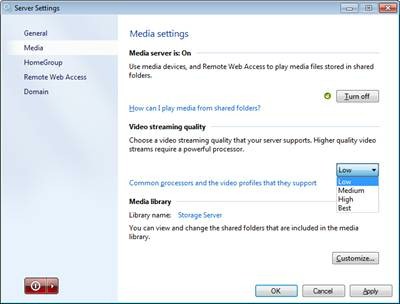
Figure 11a: Video quality setting
My only disappointment with remote access came when I tried to connect for a remote desktop session. Several of my computers were reported as a “not supported operating system” even though they were running Windows.
In order to access the remote desktop via the Launchpad Remote Access feature, you must be using Internet Explorer, and have the remote desktop services ActiveX component installed (Figure 11b). I was able to connect to one of the computers, but not to the DX4000. For the one computer I connected to, it was a standard Windows remote desktop experience.
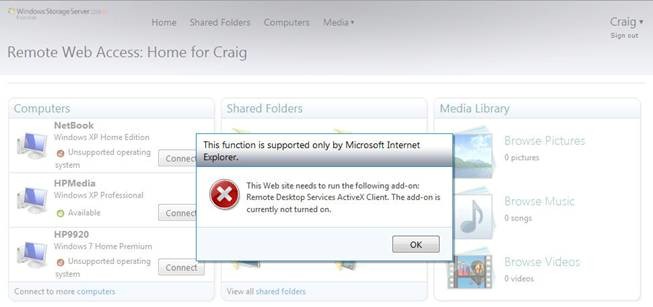
Figure 11a: Remote access error
Given WD’s stated business focus for the Sentinel, it’s odd to see so many media features. But I guess since they come with WSS 2008 R2 Essentials, WD figured they might as well pass them on to the user.
Shared Folders – When you click on Shared Folders, it opens a window showing the shared folders that you have access to on the DX4000. Figure 12 shows my shares on the DX4000.
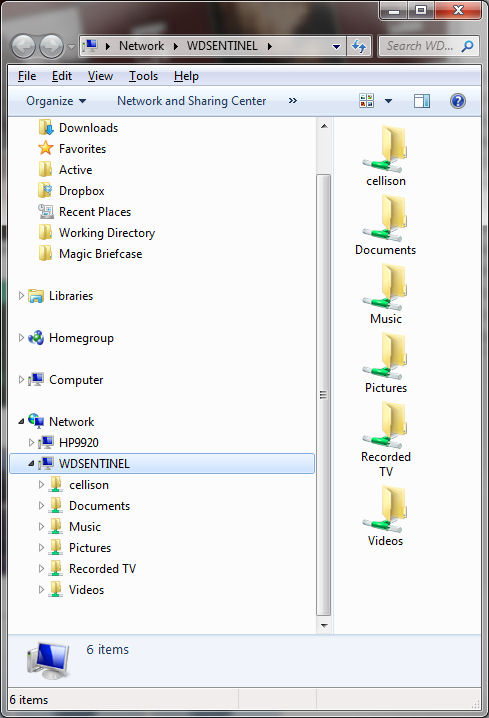
Figure 12: Shares configured for access by user cellison
Dashboard – This is just a shortcut to access the Dashboard program, which I’ll discuss next.
Dashboard
As noted earlier, the Dashboard is the administrator’s console. From here, you can add/manage users and shares, create computer backup profiles, restore files and monitor the health and status of the DX4000.
Figure 13 shows the home page of the Dashboard. I’ll talk a little about each of the menus for the icons that run across the top of the screen.
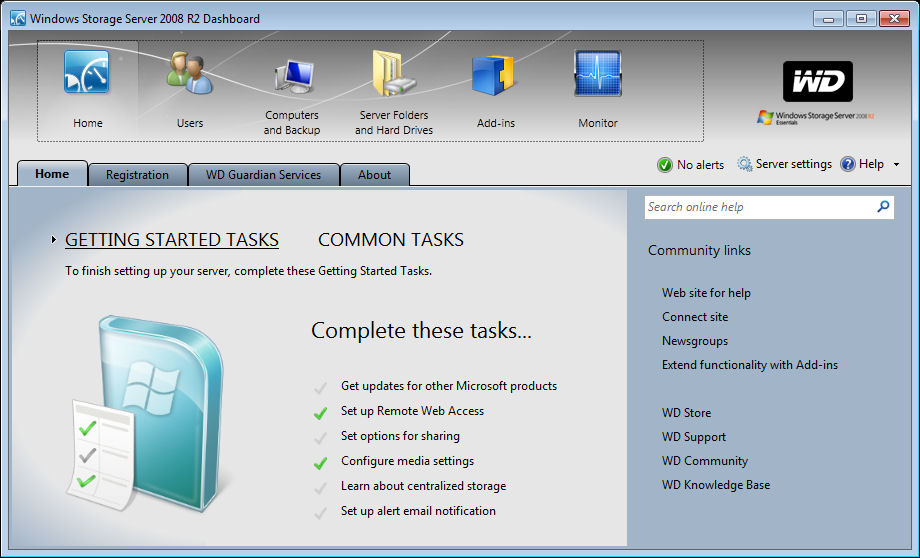
Figure 13: Dashboard home screen
Users – This is where you can create user accounts and set password policies. However, the password policy only pertains to the password strength, and not how often the users have to change their passwords. You can also remove an account, deactivate it or change the account password. Figure 14 shows the properties for my account. As you can see, you can individually grant or deny remote web access on a user by user basis.
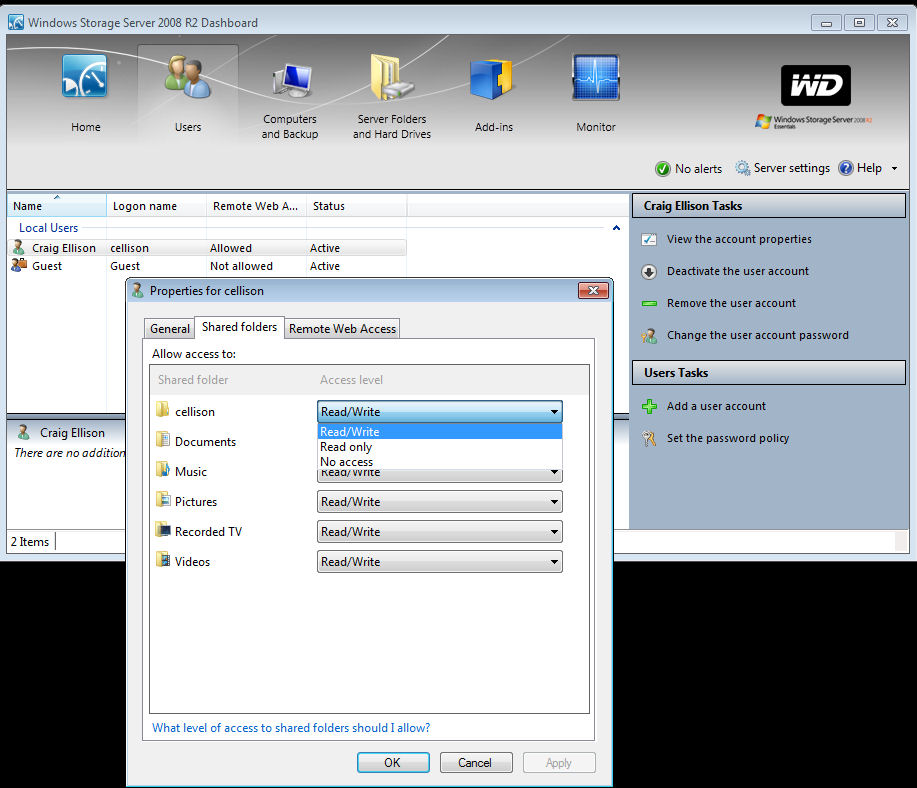
Figure 14: User properties for cellison. This tab shows access rights for shared folders
Computers and Backup – In this menu, the organization is based on computers, not users. In Figure 15, the column in on the right shows the basic tasks available for each user.
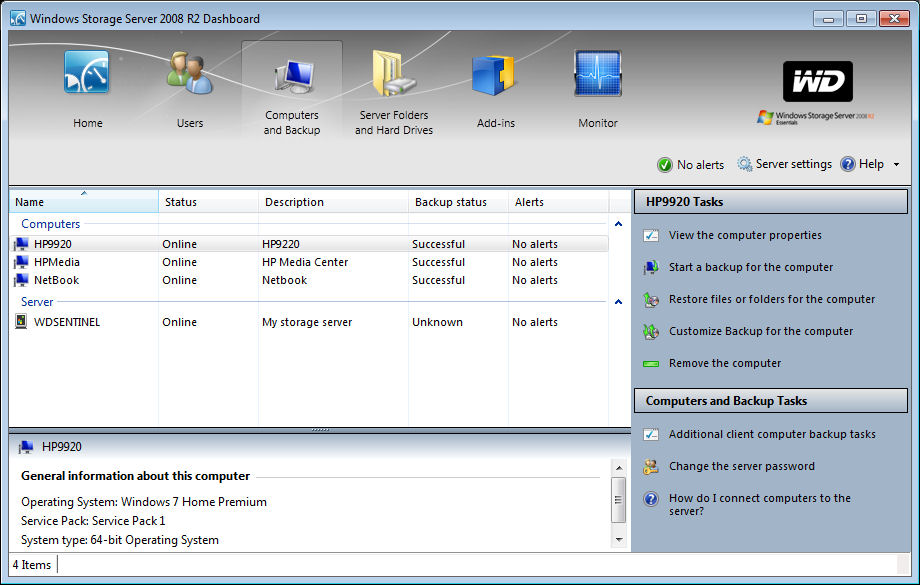
Figure 15: Computers and backup menu
By default, the local RAID 5 volume as well as any attached USB drives are completely backed up. You have the option, however, for each computer, to create a custom backup that backs up only administrator-specified folders. Computer properties shows general information about the computer, as well as the backup history.
The additional client computer backup tasks, shown in the lower right corner of the above screen, allow you to set global parameters for backups. You can specify a start and end time for the backup cycle as well as set a daily, weekly and monthly backup retention policy. In addition, you can create a USB boot key should you need to do a "bare metal" restore.
While Launchpad supports backup of MacOS clients, you can’t use any of the DX4000’s storage as a target for Apple Time Machine backups.
For some quick tests, I backed up an entire computer as well as selected directories on two other computers. While I didn’t create a USB bootable key to do a bare metal restore, I did restore some files from the server.
I navigated to a backup session I made of one of the computers and selected the drive and directory I wanted to restore. After selecting it, I had the option of restoring files or directories to anywhere my computer had access to, but not to the original location on the original computer.
I restored both to another NAS drive as well as to my local drive. I was surprised to see that Windows Explorer reported only about 1.45 MB/s while copying the restored files. Restoring from the DX4000 to another NAS, both connected by Gigabit Ethernet, was even slower. I’m glad I didn’t try to recover multiple Gigabytes of data!
Server Folders and Hard drives – In this menu, you add, delete and move folders, stop sharing and view folder properties. New folders are added at the root of D:\ServerFolders, and cannot be added as a sub-folder to a currently shared folder. Also, none of the system-defined folders can be deleted.
Figure 16 shows the Server Folders tab along with folder properties for cellison. You can see that my private folder has 8.4 GB of data. There is no provision within the DX4000 to apply user disk quotas! The sharing tab (not shown) displays user rights granted to the folder. The Hard Drives tab shows how the array is partitioned. For this model, there’s a 60 GB C drive and a 5528.8 GB D drive.
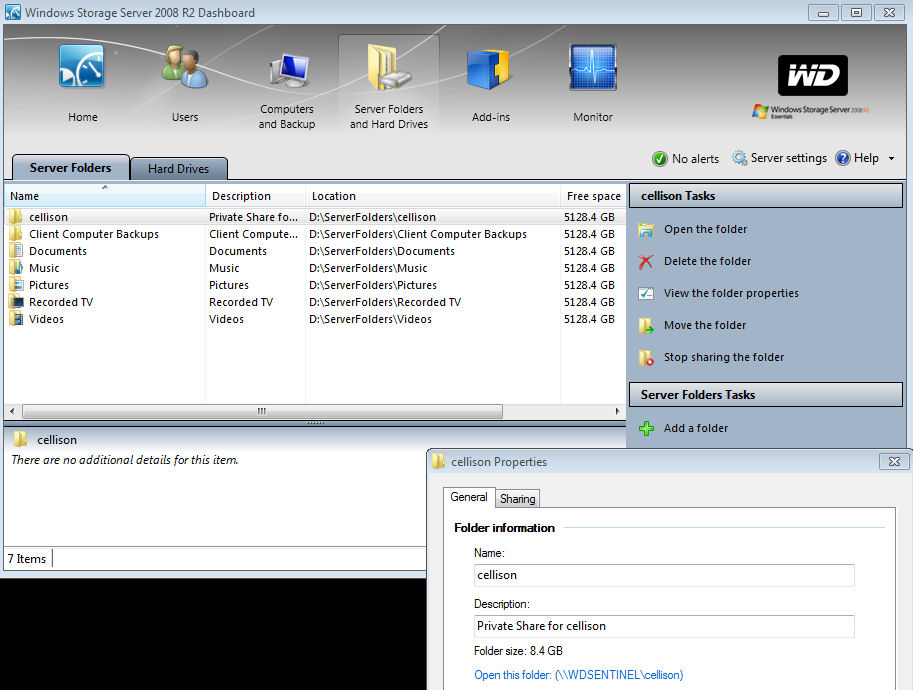
Figure 16: Server Folders and Hard Drives
Add-ins – In this menu, you can add additional features and functions to your server from Microsoft or other Independent Software Vendors (ISVs).
Monitor – The Health tab gives you a summary of the status of your DX4000 as shown in Figure 17. The Software Update tab lets you specify when the server checks Western Digital for updates. By default, the server will check for updates every Sunday at 12:00 AM. WD warns you that an automatic reboot may be required after a successful update.
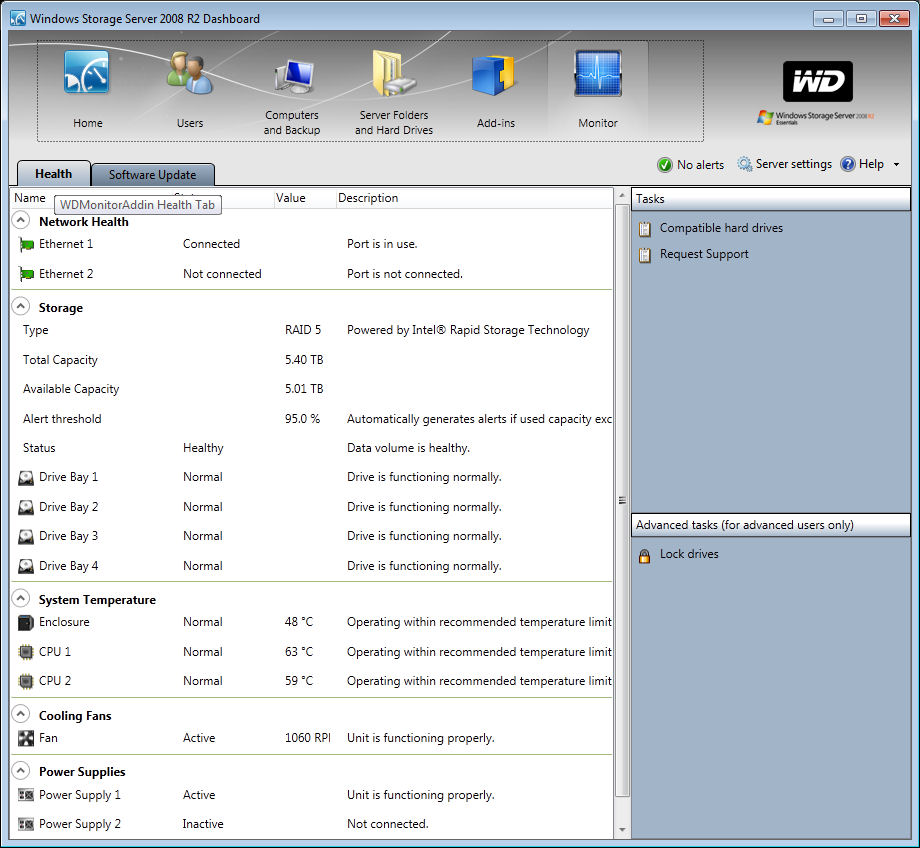
Figure 17: Monitor menu shown DX4000 status
Dashboard – more
Server Settings – When you click on Server Settings in the upper right hand corner, a separate window opens (Figure 18). The screens are quite simple, so I’ll just comment briefly on each one with the exception of Remote Web Access.
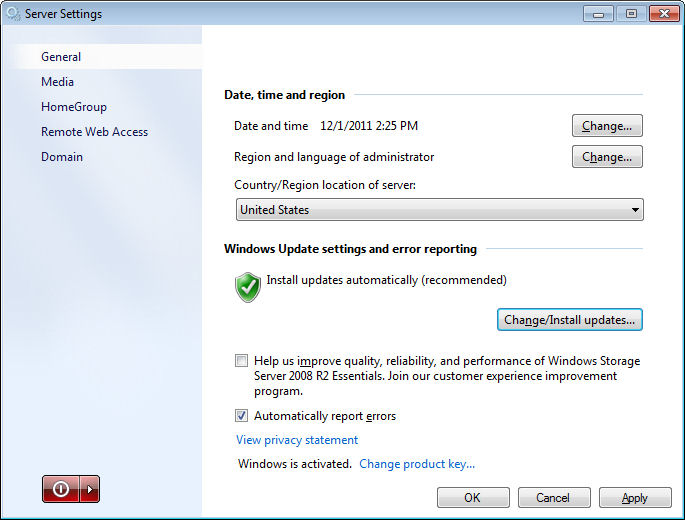
Figure 18: Server Settings menu
General – Here you can change the time and date, the language and the country/region for the server. Under Date and Time, you can set the time zone, manually adjust the time, or accept the default NTP time server of time.microsoft.com. You can also determine how the server handles Microsoft updates. (Under the Monitor menu for the previous screen, you controlled updates from Western Digital.)
Media – In this menu, you have the ability to enable/disable the media server, adjust the video streaming quality, rename the media server library, and determine which folders are to be included in the Media library. As a test, I included my cellison folder, and media files I placed in that folder appeared in the media library.
Home Group – you have an option to join a Windows Homegroup.
Remote Web Access – Figure 19 shows the Remote Web Access configuration page. You have the option of disabling Remote Web Access for all users. The repair button attempts to repair a broken connection. The server determines your public IP address (grayed out to obscure my public IP address) as well as your router type.
More details shows you the IP address of your server. Clicking on the setup button next to domain name launches a wizard that takes you through the process of creating your own domain name. You merely choose a name and a domain from a dropdown box. The server checks to see if the domain is available and if so, sets up your server for remote access.
It’s important to note that remote web access uses inbound ports 80 and 443. The DX4000 expects to use UPnP to configure your router, so make sure that you have UPnP enabled on the router. If your router doesn’t support UPnP, you’ll need to manually forward the inbound ports to the IP address of your DX4000. So you’ll probably want to make sure that the DX4000 has a static IP address.
Also, be sure that you don’t have any other remote web-enabled devices on your network, such as web cameras, competing for those ports, or the DX4000 remote web access will fail.
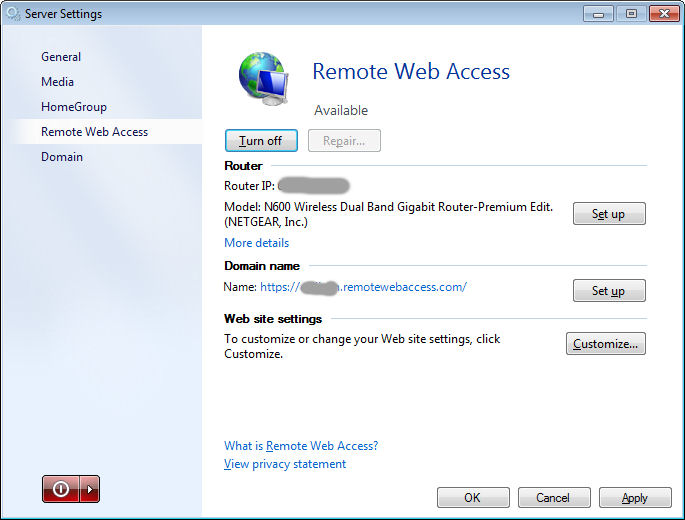
Figure 19: Remote Web Access setup page
Domain – Here you can join the DX4000 to a Windows domain.
Drive Pull Test
I already had a preview of the RAID reinitialization time. But, of course, I still had to do the standard drive pull test. I started copying about 5 GB of music to the server and Windows 7 reported a copy speed of about 14.5 MB/s. I then pulled drive #4 and the file copy continued. After a few seconds, the front panel indicator light started to flash red, and the front panel LCD displayed STORAGE DEGRADED.
At that point, file copy speed dropped to about 9 MB/s. A red critical alert showed up on the dashboard, which, when clicked, directed me to check to see if there were any missing or failed drives. Of course, I could have also set up email notifications, as well. Figure 20 shows the Dashboard alert for the failed drive.
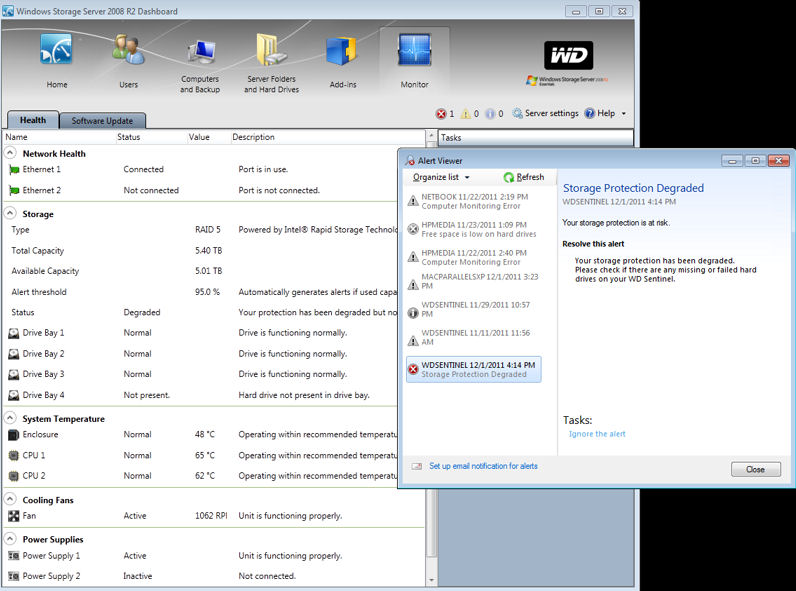
Figure 20: Dashboard showing failed or missing drive
Before re-inserting the “failed” drive, I checked, and the Dashboard interface was still responsive. I reinserted the disk and it took the DX4000 about 20 seconds to recognize it. The status light turned solid blue and the LCD screen reported REPAIRING… I started to copy some additional music files while the repair was taking place, and the copy rate bounced between 1.36 and 1.76 MB/s, i.e. almost unusably slow.
For some reason, the RAID volume repair initiated by the drive pull ran faster than the "reinitialization" caused by pulling the plug. It completed in about 15 hours vs. the 6+ days for the reinitialize. If we get an explanation of the stark difference between the two times, we’ll let you know.
Closing Thoughts
I’ll have to admit, my initial out of box experience wasn’t a very positive one. The connector software initially failed to install on any of the three systems I tried it on. In all fairness, I decided to give the connector installation one final shot and installed it in a virtual machine running XP on my Mac. It installed flawlessly in about 24 minutes or so. Go figure. I have sent my log files to WD and will report back if they come up with a root cause for my installation woes.
While the connector does allow for centralized backup and monitoring of connected systems, it can take up to 30 minutes to install, and only one installation can run at a time. For deployment in a medium-sized office, that could take quite a while.
I also don’t like that the server management is done through a separate piece of software rather than through a web browser. Browser-based management on NAS products has been the standard for years. Note that you can always connect to the DX4000 via Windows Remote Desktop if you want direct access to tweak any knobs instead of going through Dashboard.
My major complaint with the DX4000 is the extensive amount of time that it takes to rebuild the RAID in the case of a crash, failed disk or power outage. The poor performance experienced during the rebuild and the lack of fault tolerance during the rebuild may make this device unsuitable for some business environments.
On the positive side, once I had the connectors installed and the device was functioning at full speed, I found the DX4000 easy to use and configure. The menu system is simple enough that it won’t overwhelm non-technical users. I really liked the web remote access and thought that media aggregation into libraries was a nice feature. I was a bit surprised, however, that media serving was an included feature for a device targeted at the business audience. Still, you can disable that function if you want to.
Unfortunately, my experience using browser-based Remote Desktop via Remote Web Access was mixed. Even when I used Internet Explorer as required, it worked on some systems, and not on others and didn’t work with the DX4000 itself. With all of the more fully-featured remote desktop products on the market such as LogMeIn and GoToMyPC, I’d probably choose one of them rather than be tied to Internet Explorer and Remote desktop.
WD has work to do on its backup and restore features, too. I’ve already noted the lack of support for Apple Time Machine. But options for backing up the server itself are limited to attached drives. Backup to networked rsync targets or even other DX4000’s haven’t yet made it into the feature set, nor has backup to any cloud services.
In all, while there are a number of features that I like about the DX4000, installation issues, slow RAID rebuild times, slow restore times and limited server backup options keep it off of my recommended purchase list.
